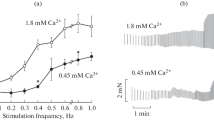Abstract
In single skeletal muscle fibres treated with low concentration of caffeine, lowering the bathing solution temperature from 18°C to below 7°C increased [Ca2+]i in three phases depending on caffeine concentration and temperature. Tension could be fully developed (rapid cooling contracture, RCC) by the second phase of the released Ca2+. The second and third phases were inhibited by low concentrations of procaine, and the first phase was blocked by a higher one. RCC was observed even in Ca2+-free solution. The mechanism of [Ca2+]i changes and RCC during cooling was discussed.
Access this chapter
Tax calculation will be finalised at checkout
Purchases are for personal use only
Preview
Unable to display preview. Download preview PDF.
Similar content being viewed by others
References
Allen, D.G. and Blinks, J.R. (1979). The interpretation of light signals from aequorin-injected skeletal and cardiac muscle cells: A new method of calibration. In: Detection and Measurement of Free Ca2+ in Cells. pp. 159–174, ed. Ashley, C.C. and Campbell, A.K. Elsevier/North-Holland.
Blinks, J.R. and Rüdel, R. and Taylor, S.R. (1978). Calcium transients in isolated amphibian skeletal muscle fibres: Detection with aequorin. J. Physiol. 277: 291–323.
Ebashi, S. and Endo, M. (1988). Calcium and muscle contraction. Prog. Biophy. Mol. Biol. 18: 123–183.
Endo, M. (1975). Mechanism of action of caffeine on the sarcoplasmic reticulum of skeletal muscle. Proc. Japan Acad. 51: 479–484.
Lilttgau, H.C. and Oetliker, H. (1968). The action of caffeine on the activation of the contractile mechanism in striated muscle fibres. J. Physiol., 194: 51–74.
Sakai, T. and Kurihara, S. (1974). A study on rapid cooling contracture from the view point of excitation-contraction coupling. Jikeikai Med. J. 21: 47–88.
Thorens, S. and Endo, M. (1975). Calcium-induced calcium release and “Depolarization”- induced calcium release: their physiological significance. Proc. Japan Acad. 51: 473–478.
Author information
Authors and Affiliations
Editor information
Editors and Affiliations
Rights and permissions
Copyright information
© 1984 Plenum Press, New York
About this chapter
Cite this chapter
Kurihara, S., Konishi, M., Sakai, T. (1984). Changes in [Ca2+]i Induced by Rapid Cooling of Single Skeletal Muscle Fibres Treated with Low Concentration of Caffeine. In: Pollack, G.H., Sugi, H. (eds) Contractile Mechanisms in Muscle. Advances in Experimental Medicine and Biology, vol 37. Springer, Boston, MA. https://doi.org/10.1007/978-1-4684-4703-3_50
Download citation
DOI: https://doi.org/10.1007/978-1-4684-4703-3_50
Publisher Name: Springer, Boston, MA
Print ISBN: 978-1-4684-4705-7
Online ISBN: 978-1-4684-4703-3
eBook Packages: Springer Book Archive




